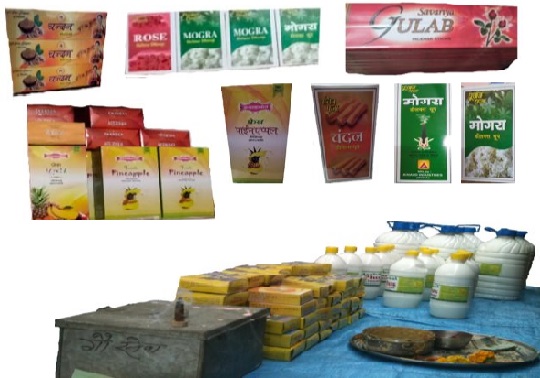Our Projects
Eco-friendly Plate Production: Empowering Communities, Protecting Nature
At our facility, we craft plates of all sizes from paper materials that are entirely free from plastic. In the mountains, we exclusively use disposables made from paper and leaves, reducing pollution caused by plastics. This initiative aims to mitigate the impact of any pollution in the future, ensuring thinner plates from tree leaves, offering employment opportunities for many underprivileged individuals.
In the future, the committee plans to create disposables from tree leaves like areca, banana, pineapple, and other large tree leaves that will be completely eco-friendly, causing no harm to nature. This initiative will provide employment to many unemployed individuals. Using these leaves can also help reduce the impact of forest fires in the mountains. Both the government and affluent individuals should extend ample support towards this cause.

Innovative Products for Health and Wellness: Harnessing Natural Resources
The committee is actively engaged in the production of incense sticks and agarbattis, while also strategizing for the future development of dhoop made from cow dung and cow urine. This forward-thinking initiative seeks to explore innovative methods to create herbal finials that possess potential antiviral properties, specifically targeting and combating the spread of dangerous viruses transmitted by mosquitoes, such as dengue. By delving into the utilization of natural resources like cow dung and cow urine, the committee aims to craft effective solutions that not only contribute to the creation of aromatic products but also harness the potential of these organic substances to develop herbal finials capable of mitigating the risks posed by viral infections, thereby promoting public health and well-being.
Preserving Craftsmanship: Sustainable Livelihoods from Mountain Treasures
The committee is dedicated to the promotion and conservation of intricately crafted baskets and various other products fashioned from the trees and branches indigenous to the mountainous regions. This comprehensive endeavor not only seeks to celebrate the beauty and craftsmanship of these locally sourced materials but also aims to foster their preservation as a testament to the region’s rich cultural heritage and natural resources.
Through the promotion and sustenance of these artisanal products, the committee envisions an expansive scope for employment generation within the community. By encouraging the utilization of these mountain trees and branches in crafting these unique items, the committee strives to create a sustainable economic ecosystem that offers an abundance of employment opportunities to local artisans and individuals, thereby contributing to the socio-economic development and empowerment of the region.
Sustaining Mountain Herbs: Empowering Communities with Ayurvedic Produce
Nestled within the forests of the mountains lie a plethora of invaluable herbs, a treasure trove that faces the threat of annual losses due to devastating wildfires. The committee has set its sights on a profound mission—to safeguard and cultivate these precious herbs, thereby ensuring their conservation for generations to come. Recognizing the untapped potential of these natural resources, the committee seeks not only to protect these herbs but also to leverage their inherent value for the betterment of the community.
This ambitious initiative encompasses a multifaceted approach aimed at both conserving these herbs and harnessing their potential for economic and social benefit. By cultivating these herbs, the committee envisions the creation of employment opportunities for a substantial number of individuals, paving the way for sustainable livelihoods within the region. Moreover, the planned production of various Ayurvedic spices of significant medicinal and cultural importance serves as a testament to the committee’s commitment to preserving traditional knowledge and fostering a thriving ecosystem that honors the heritage and healing properties of these mountainous herbs. Through this comprehensive effort, the committee aspires not only to protect the herbs from wildfire-induced losses but also to unlock their potential for the greater welfare and prosperity of the community.
Transforming Nature's Canvas: Artisanal Employment for Mountain Youths
The mountains boast a picturesque landscape adorned with meandering rivers, serene streams, majestic waterfalls, and an array of stones exhibiting diverse sizes and captivating colors along their banks. Envisioning the potential in these natural elements, the committee has a forward-looking vision to harness the beauty of these stones for artistic creations.
This visionary plan aims to transform these stones into exquisite artworks, fostering a creative industry that not only celebrates the natural splendor of the region but also generates substantial employment opportunities for numerous unemployed youth and children. Through this innovative approach, the committee endeavors to unlock the artistic potential of these natural resources, simultaneously providing a means for livelihood and empowerment to a significant number of individuals within the community.
Harnessing Solar Power: Resilience and Employment in the Mountains
In order to protect the mountains from potential disasters, it is imperative to harness the full potential of solar energy. The envisioned strategy involves the widespread adoption of solar technology across every village nestled in the mountains. This comprehensive approach aims to deploy solar lanterns, lighting systems, and a range of small-scale solar-powered products.
One of the primary focuses is on employing solar water pumps to provide access to water at elevations ranging from 100 to 300 meters. This proactive step aims to address and mitigate future water scarcity issues in these regions, ensuring a sustainable water supply for communities in challenging terrain.
The utilization of solar products is anticipated to have a transformative impact, particularly in generating employment opportunities for the unemployed population. This initiative envisages the revival and establishment of small-scale industries in remote and rugged areas, rejuvenating local economies and fostering growth in regions where traditional employment avenues might be limited. By leveraging solar technology as a catalyst, this initiative seeks to not only mitigate environmental risks but also to stimulate economic development, empowerment, and resilience within these mountainous communities.















